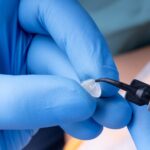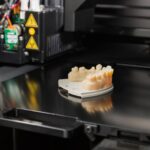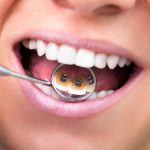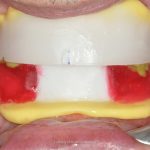Polyvinylsiloxanes (PVSs), or addition silicones, are elastomers that are widely used as impression materials in dentistry. (1) Thanks to their advanced characteristics, PVSs are currently considered the gold standard for accurate impressions.
They offer excellent levels of precision, accuracy and elasticity, and boast high dimensional stability too. For these reasons, they are also ideal for use in applications other than impression taking.
One of the most common applications of PVSs, outside the field of impressions, is in the production of silicone masks or indices, starting from a diagnostic wax-up. Silicone indices can be used to produce pre-prosthetic mock-ups using self-curing resin (2) and as guides for direct reconstruction (3).
Because traditional PVSs are opaque and coloured, however, they are unable to transmit light. In these applications, therefore, they cannot be used with conventional light-curing composites but only with self-curing bis-acrylic or methacrylate materials, with all the associated disadvantages.
Clear PVS materials have therefore been developed to allow the passage of light, permitting visual inspection and light curing.
Clear silicones
Clear silicones are not intended for use as traditional impression materials. Rather, they are formulated for special restorative and prosthetic applications in which the curing process needs to be controlled by means of a mask or index.
For a clear silicone to be easy to use in such applications, it must have the following characteristics:
- It must be accurate enough to faithfully reproduce a diagnostic wax-up and to be repositioned accurately over the patient’s teeth.
- It must be rigid enough to contain a composite material without deformation, but elastic enough to fit undercuts without breaking.
- It must be transparent enough to permit the passage of UV light from a curing lamp and allow the visual inspection of features under the mask.
Let us now move on to the clinical applications of clear silicones.
Diagnostic mock-ups
For a start, you can use clear silicones to produce diagnostic mock-ups. (4) In cases of seriously worn dentition, where the vertical dimension is significantly reduced, you should always produce a temporary reconstruction before moving on to the final version. Temporary mock-ups improve patients’ motivation towards treatment and permit the functional aspects of an increase in the DVO to be properly evaluated. Even in purely aesthetic cases limited to the front sector, a mock-up allows both patient and dentist to preview the final result. The mock-up is generally left in place for a certain period of time to verify the patient’s aesthetic, phonetic and functional parameters and assess whatever modifications may be necessary.
Apply clear silicone to the dental technician’s diagnostic wax-up using the tip and then form it into the required shape by means of a spatula. Once the material is completely cured, remove it from the wax-up. (It can be immersed in hot water to complete the curing process and maximise rigidity.) The mock-up can now be tested in the mouth. First isolate the most significant interproximal level undercuts with teflon, then place the heated composite inside the transparent matrix. Alternatively, where teeth need to be restored, you can use a flowable composite with a high filler content. Position the transparent matrix filled with the composite resin in the mouth using finger pressure. Use a probe to remove any excess product squeezed out during positioning. Curing can now take place, first with the transparent matrix in place and then directly once the matrix has been removed. Since no adhesive phase has been involved (spot etching can be used if necessary) the mock-up remains in place thanks to the undercuts but can nevertheless be removed easily.
Now let us examine the Clear Index Technique. (5.6)
The Clear Index Technique
You can use this technique to restore all the teeth (front or rear) in a quadrant with the aid of a clear silicone index. This is a very convenient technique when dealing with worn dentition, when the vertical dimension of teeth has to be restored adopting an entirely adhesive approach. A diagnostic wax-up must first be produced in the lab, to correct the vertical dimension of the teeth. Inject the clear silicone into this diagnostic wax-up and wait until curing is complete. Once the index is removed from the wax-up, you can immerse it in hot water to cure it further. Once the index is cured, use a scalpel to trim it, but do so one tooth at a time: one index per tooth.
Now isolate the operating field with a rubber dam. Test the individual indices on the teeth in need of reconstruction and finish if necessary. Position two metal matrices at the interproximal level to protect the points of contact. Etch the tooth and apply the adhesive phase. Heat the composite (to make it more fluid) and apply slightly more than is needed to the tooth to be reconstructed, then press the index firmly into place (this is why it needs to be fairly rigid). Use a probe to remove any excess composite forced out between the index and the tooth. Once all excess material has been removed, cure the material, first through the clear index and then directly, having removed the index. Finish and polish the tooth before repeating the process on the other teeth.
The Injection Technique is another, more recent alternative. (7-9)
The Injection Technique
Perform the steps described above on the diagnostic wax-up to create a transparent matrix or index of the area in need of restoration. Once the silicone is fully cured, you can cover it with a sheet of thermoformed acetate to increase its rigidity so that the pressure generated by the injection of the flowable composite does not cause distortion. You can now test the matrix in the patient’s mouth. Use a diamond bur to make through-holes in the transparent matrix at the incisal margins or occlusal surfaces of the teeth to be restored. These holes must be large enough to accommodate the tip of the syringe containing the flowable composite.
Isolate teeth that do not require restoration with teflon. If contiguous teeth in the same quadrant have to be restored, they must be isolated from each other and separate injections made to avoid invading the interproximal area and connecting the two contiguous teeth with flowable composite. For example, if all the teeth from the second molar to the first premolar need to be restored, begin by isolating the first molar and the first premolar and then, in the next phase, the second molar and second premolar.
Once the teeth have been isolated and the adhesive phase applied, fit the index, making sure it is correctly positioned. Push the tip of the syringe containing the flowable composite into the holes in the masks and inject the composite resin fluid, maintaining a constant pressure. Check that all the gaps between the mask and the teeth have been filled, then proceed with curing, first through the mask and then directly, having removed the mask. Move the teflon to isolate the teeth that have just been restored, so that you can restore the remaining teeth without any risk of flowable composite filling the interproximal gaps. Once you have treated all the teeth in this way, you can finish and polish them.
The above techniques offer a number of major advantages. (5)
The advantages of techniques based on clear silicone
Because these techniques are purely adhesive, treatment is completely additive and procedures that reduce healthy dental structure are not needed. These techniques can therefore be defined as minimally invasive. The procedures are also completely reversible: if it ever proves necessary, initial conditions can be restored simply by removing the composite with a bur. Another key advantage of these techniques is that restorations in composite material are easy to repair using the right adhesive procedure. These techniques are also a lot faster than conventional ones and less expensive for the dentist and therefore for the patient.
The Zhermack solution for the production of transparent matrices
To sum up, the outlook for these procedures is excellent: only the future literature can tell us how such restorations perform over time, of course. Zhermack has formulated and developed Elite Glass, a special clear silicone-a for the production of the transparent matrices needed for these applications. Thanks to its excellent accuracy, transparency and post-curing rigidity, Elite Glass is particularly effective in the production of transparent matrices using the direct technique.
Bibliography
(1) Mandikos, M. N. (1998). Polyvinyl siloxane impression materials: an update on clinical use. Australian dental journal, 43(6), 428-434.
(2) Magne, P., & Magne, M. (2006). Use of additive waxup and direct intraoral mock-up for enamel preservation with porcelain laminate veneers. European Journal of Esthetic Dentistry, 1(1), 10.
(3) Paolone, G. (2014). Direct composite restorations in anterior teeth. Managing symmetry in central incisors. Int J Esthet Dent, 9(1), 12-25.
(4) Fabbri, G., Cannistraro, G., Pulcini, C., & Sorrentino, R. (2018). The full-mouth mock-up: a dynamic diagnostic approach (DDA) to test function and esthetics in complex rehabilitations with increased vertical dimension of occlusion. Int J Esthet Dent, 13(4), 460-74.
(5) Ammannato, R., Ferraris, F., & Marchesi, G. (2015). The “index technique” in worn dentition: a new and conservative approach. Int J Esthet Dent, 10(1), 68-99.
(6) Ammannato, R., Rondoni, D., & Ferraris, F. (2018). Update on the ‘index technique’in worn dentition: a no-prep restorative approach with a digital workflow. Int J Esthet Dent, 13(4), 516-37.
(7) Ypei Gia, N. R., Sampaio, C. S., Higashi, C., Sakamoto Jr, A., & Hirata, R. (2021). The injectable resin composite restorative technique: A case report. Journal of Esthetic and Restorative Dentistry, 33(3), 404-414.
(8) Geštakovski, D. (2019). The injectable composite resin technique: minimally invasive reconstruction of esthetics and function. Quintessence Int, 50(9), 712-720.
(9) Hosaka, K., Tichy, A., Motoyama, Y., Mizutani, K., Lai, W. J., Kanno, Z., … & Nakajima, M. (2020). Post‐orthodontic recontouring of anterior teeth using composite injection technique with a digital workflow. Journal of Esthetic and Restorative Dentistry, 32(7), 638-644.
Do you want more information on Zhermack Dental products and solutions?
Contact us




 Zhermack SpA has been one of the most important producers and international distributors of alginates, gypsums and silicone compounds for the dental sector for over 40 years. It has also developed solutions for the industrial and wellbeing sectors.
Zhermack SpA - Via Bovazecchino, 100 - 45021 Badia Polesine (RO), Italy.
Zhermack SpA has been one of the most important producers and international distributors of alginates, gypsums and silicone compounds for the dental sector for over 40 years. It has also developed solutions for the industrial and wellbeing sectors.
Zhermack SpA - Via Bovazecchino, 100 - 45021 Badia Polesine (RO), Italy.


